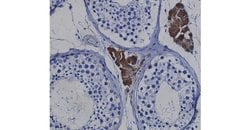Learn More
Invitrogen™ MERTK Monoclonal Antibody (A3KCAT), eBioscience™
Mouse Monoclonal Antibody
Supplier: Invitrogen™ 14905382

Description
This A3KCAT antibody recognizes human MerTK, known also as MER or c-mer, a 170-210 kDa member of the TAM family of tyrosine kinase receptors that also includes Axl and Tyro3. MerTK is expressed on a subset of anti-inflammatory macrophages and is involved in the removal of apoptotic cells. This process relies on two soluble ligands of MerTK, Protein S and Gas6, that coat the surface of cells undergoing apoptosis. Upon binding these ligands, MerTK undergoes autophosphorylation at multiple tyrosine residues that activate the PI3K and Akt pathways. This results in the phagocytosis of target cells and also the direct inhibition of TLR-induced production of pro-inflammatory cytokines by the phagocytes. MerTK may also function as a putative entry receptor for filoviruses. Deficiency of MerTK causes general autoimmunity, inflammation, and accumulation of apoptotic bodies. MerTK can be released from the cell surface by metalloproteinases, and this process is significantly enhanced when macrophages are stimulated e.g. with LPS. MerTK is often expressed on malignant cells, and may be implicated in immune evasion. This A3KCAT antibody has been tested by immunohistochemistry of formalin-fixed paraffin embedded tissue using low or high pH antigen retrieval and can be used at less than or equal to 0.5 μg/mL. It is recommended that the antibody be carefully titrated for optimal performance in the assay of interest. Purity: Greater than 90%, as determined by SDS-PAGE. Aggregation: Less ...
MERTK (cMER) is a tyrosine kinase proto-oncogene and is involved in the retinal pigment epithelium (RPE) phagocytosis pathway, which is implicated in human retinal disease. Regulates many physiological processes including cell survival, migration, differentiation, and phagocytosis of apoptotic cells (efferocytosis). Ligand binding at the cell surface induces autophosphorylation of MERTK on its intracellular domain that provides docking sites for downstream signaling molecules. Following activation by ligand, interacts with GRB2 or PLCG2 and induces phosphorylation of MAPK1, MAPK2, FAK/PTK2 or RAC1. MERTK signaling plays a role in various processes such as macrophage clearance of apoptotic cells, platelet aggregation, cytoskeleton reorganization and engulfment. Functions in the retinal pigment epithelium (RPE) as a regulator of rod outer segments fragments phagocytosis. Plays also an important role in inhibition of Toll-like receptors (TLRs)-mediated innate immune response by activating STAT1, which selectively induces production of suppressors of cytokine signaling SOCS1 and SOCS3.
Specifications
| MERTK | |
| Monoclonal | |
| 0.5 mg/mL | |
| PBS with 0.09% sodium azide | |
| Q12866 | |
| Mertk | |
| Full extracellular domain of human MerTK (N-terminal part). | |
| 100 μg | |
| Primary | |
| Human | |
| Antibody | |
| IgG1 κ |
| Immunohistochemistry (Paraffin) | |
| A3KCAT | |
| Unconjugated | |
| Mertk | |
| c-Eyk; c-mer; c-mer proto-oncogene tyrosine kinase; Eyk; MER; MER proto-oncogene, tyrosine kinase; MER receptor tyrosine kinase; MERTK; MGC133349; nmf12; Nyk; Proto-oncogene c-Mer; proto-oncogene tyrosine-protein kinase MER; rdy; receptor tyrosine kinase MerTK; Receptor tyrosine tinase gene probably the gene for Rdy; retinal dystrophy; RP38; sMER; sMERTK; soluble MER; soluble MERTK; STK kinase; Tyro 12; Tyro12; Tyrosine-protein kinase Mer | |
| Mouse | |
| Affinity chromatography | |
| RUO | |
| 10461 | |
| 4°C, store in dark, DO NOT FREEZE! | |
| Liquid |
Safety and Handling
The Fisher Scientific Encompass Program offers items which are not part of our distribution portfolio. These products typically do not have pictures or detailed descriptions. However, we are committed to improving your shopping experience. Please use the form below to provide feedback related to the content on this product.

